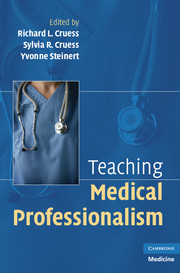Book contents
- Frontmatter
- Contents
- List of Contributors
- Foreword by William M. Sullivan
- Introduction
- PART ONE WHAT IS TO BE TAUGHT
- PART TWO THEORY
- PART THREE PRINCIPLES
- PART FOUR PRACTICE: CASE STUDIES IN TEACHING PROFESSIONALISM ACROSS THE CONTINUUM
- APPENDIX A Definitions of Professionalism
- APPENDIX B Core Attributes of Professionalism
- APPENDIX C The Teaching of Professionalism: Vignettes for Discussion
- APPENDIX D A Matrix for “Matching” Teaching Methods to Attributes
- APPENDIX E Sample Grid for Use with Discussion of Vignettes
- APPENDIX F Sample Questions to Guide Discussion about the Social Contract: Small-Group Leaders' Guide with Suggested Responses
- APPENDIX G Professionalism Program for Residents: Suggested Outline for Small Group Facilitators
- APPENDIX H Sample Evaluation Form for Residents' Half-Day Program on Professionalism
- Index
- References
Introduction
Published online by Cambridge University Press: 01 September 2009
- Frontmatter
- Contents
- List of Contributors
- Foreword by William M. Sullivan
- Introduction
- PART ONE WHAT IS TO BE TAUGHT
- PART TWO THEORY
- PART THREE PRINCIPLES
- PART FOUR PRACTICE: CASE STUDIES IN TEACHING PROFESSIONALISM ACROSS THE CONTINUUM
- APPENDIX A Definitions of Professionalism
- APPENDIX B Core Attributes of Professionalism
- APPENDIX C The Teaching of Professionalism: Vignettes for Discussion
- APPENDIX D A Matrix for “Matching” Teaching Methods to Attributes
- APPENDIX E Sample Grid for Use with Discussion of Vignettes
- APPENDIX F Sample Questions to Guide Discussion about the Social Contract: Small-Group Leaders' Guide with Suggested Responses
- APPENDIX G Professionalism Program for Residents: Suggested Outline for Small Group Facilitators
- APPENDIX H Sample Evaluation Form for Residents' Half-Day Program on Professionalism
- Index
- References
Summary
The practice of medicine is an art, not a trade; a calling, not a business; a calling in which your heart will be exercised equally with your head.
This book is about education. While the subject is about teaching and learning professionalism, the authors discuss how best to educate the physicians of the future who will be responsible for much of the health and well-being of their fellow citizens. While medical education often appears to have developed in isolation from the formal world of pedagogy, medical students are adult learners and the science of cognition applies to them as it does to other learners. Through the centuries, we have come to understand a great deal about education, but there is still much that we do not know and probably will never fully comprehend. For a period of time, both general and medical education placed great emphasis on the acquisition of knowledge and skills. In our knowledge-based world, this is certainly appropriate, as one cannot function without a minimal level of knowledge. However, recent times have seen a return to an earlier belief that education represents more than facts and figures. It has been said that education is what remains after what has been learned has been forgotten. Michael Polanyi, that wonderful combination of chemist and philosopher, coined the term “tacit knowledge” to help us understand this phenomenon. He stated that “one knows things which one cannot tell.” Tacit knowledge is acquired through experiencing a broad spectrum of life's challenges.
- Type
- Chapter
- Information
- Teaching Medical Professionalism , pp. 1 - 4Publisher: Cambridge University PressPrint publication year: 2008

